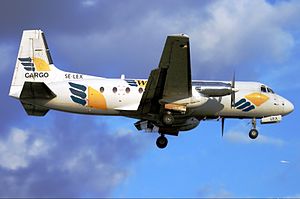Hawker Siddeley HS 748
| HS 748 | |
|---|---|
 |
|
| West Air Sweden HS 748 Srs2/244 | |
| Role | Airliner |
| Manufacturer |
Avro Hawker Siddeley Hindustan Aeronautics |
| First flight | 24 June 1960 |
| Status | Active service |
| Primary users |
Indian Air Force Indian Airlines Corporation Air North VARIG |
| Produced | 1961-1988 |
| Number built | 380 |
| Variants |
Hawker Siddeley Andover BAe ATP |
| Hi-res cutaway of BAe Coastguarder | |
|
|
The Hawker Siddeley HS 748 is a medium-sized turboprop airliner originally designed by the British firm Avro in the late 1950s as a replacement for the aging DC-3s then in widespread service as feederliners. Avro concentrated on performance, notably for STOL operations, and found a dedicated market. 380 aircraft were built by Hawker Siddeley. A larger, stretched development of the HS 748, the BAe ATP, attempted to compete with the de Havilland Canada Dash 8 but saw a limited production run.
The original 748 design was started in 1958, after the infamous Duncan Sandys 1957 Defence White Paper ended most military manned-aircraft development in the UK, and Avro decided to re-enter the civilian market.
The Vickers Viscount had the larger end of the short-haul market, and Avro therefore decided to design a smaller regional airliner powered by two Rolls-Royce Dart turboprop engines, intended to replace the many DC-3 Dakotas that were by then reaching the end of their economic lifespan. Original plans were for a 20-30 seat aircraft with a similar configuration to the Fokker F27, but talks with potential customers soon led to a low-wing 40 seat design being chosen for the 748 project.
Avro was not the only company to see the potential for a DC-3 replacement, and by this point work on the 748's direct competitor, the Fokker F27 Friendship turboprop, was well advanced. Avro therefore decided to compete by producing a more rugged design with better short-field performance, allowing it to operate from smaller airports and those with rough surfaces. This was accomplished with a long, high lift wing and a unique single slot flap with a hinged flap tab at the trailing edge. The wing was mounted low on the fuselage with dihedral from the root, allowing good overall ground clearance and easy mounting of strong durable landing gear. Other features of the 748 included an internal engine starting system, and systems and structures that were designed to be easy to inspect and repair in the field with limited equipment. The 748 was one of the first medium-sized aircraft to use fail-safe design principles in the structure, instead of the then common safe-life principles. Because of these features, the 748 quickly became popular (and still is today) with a variety of airlines operating in remote areas thanks to its ability to haul payloads of over 10,000 lbs in and out of short rough fields with little to no ground service equipment.
...
Wikipedia
